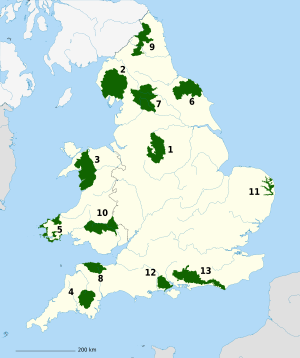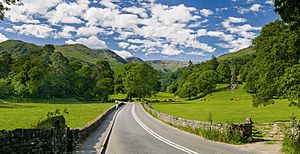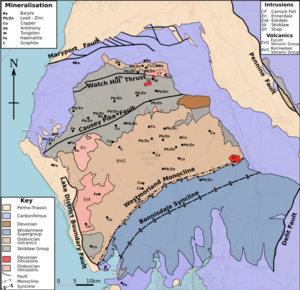Lake District facts for kids
Quick facts for kids Lake District |
|
|---|---|
| Cumbrian Mountains | |
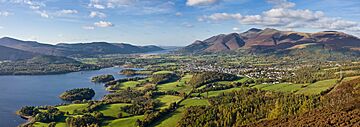
|
|
| Highest point | |
| Peak | Scafell Pike |
| Elevation | 978 m (3,209 ft) |
| Geography | |
| Location | Cumbria |
| Country | England, United Kingdom |
| Largest settlements | Kendal, Ambleside, Windermere, Keswick |
| Geology | |
| Orogeny |
|
| Age of rock | Primarily Ordovician |
| Type of rock | Primarily volcanic and sedimentary |
| Lake District National Park | |
|
IUCN Category V (Protected Landscape/Seascape)
|
|
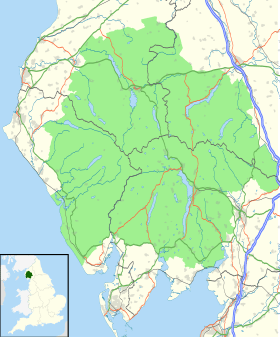
The Lake District national park
|
|
| Area | 2,362 km2 (912 sq mi) |
| Established | 9 May 1951 |
| Visitors |
|
| Governing body | Lake District National Park Authority |
| UNESCO World Heritage Site | |
| Official name | The English Lake District |
| Criteria | Cultural: ii, v, vi |
| Inscription | 2017 (41st Session) |
| Area | 229,205.19 ha |
The Lake District, also called the Lakes or Lakeland, is a beautiful mountainous area in Cumbria, North West England. It's famous for its stunning natural beauty, including many lakes, a coastline, and the Cumbrian Mountains. Many famous writers like Beatrix Potter and William Wordsworth were inspired by this place.
The Cumbrian Mountains, also known as fells, include England's highest peaks. These are Scafell Pike (978 meters or 3,209 feet), Helvellyn (950 meters or 3,117 feet), and Skiddaw (931 meters or 3,054 feet). The region also has sixteen main lakes. Windermere is the longest and largest lake in England, stretching 18 kilometers (11 miles) and covering 14.73 square kilometers (5.69 square miles). Wast Water is the deepest, at 79 meters (259 feet) deep.
The Lake District National Park was created in 1951 to protect this special area. It covers 2,362 square kilometers (912 square miles), which is most of the region. In 2017, it was recognized as a UNESCO World Heritage Site because of its unique cultural landscape.
Contents
Exploring the National Park
The Lake District National Park covers the main part of the Lake District. Some towns and coastal areas are just outside its borders. It became a national park on May 9, 1951. In 2016, the park grew by 3% to include more beautiful land to the east.
This national park is the largest of England and Wales's thirteen national parks. It is also the second largest in the United Kingdom after the Cairngorms National Park in Scotland. The park's main goal is to protect the landscape from too much industry or building. In 2017, the park was named a World Heritage Site because of its special cultural landscape.
The Lake District National Park Authority manages the park. They have offices in Kendal and run visitor centers, like Brockhole on Windermere. About 18.14 million tourists visited the park in 2022.
People and Places
Towns and Villages

The Lake District is a mountainous area, so there are only a few big towns inside it. The largest are Keswick, Windermere (which is connected to Bowness-on-Windermere), and Ambleside. These towns rely a lot on tourism. Many other important towns are close to the park's edge, like Kendal and Penrith. Smaller villages like Coniston and Grasmere are also popular.
Getting Around the Lake District
Roads for Travel
Major roads surround the Lake District, like the A6 to the east and the A66 to the north. A few main roads go right into the park. The A591 is a key road, running from Kendal through Windermere to Keswick. It was even shortlisted as one of the "Most Romantic Streets" in 2011! Other roads, like the A593, connect different areas. Some smaller roads, called B roads, go into valleys that don't have A roads. Some mountain passes, like Hardknott and Wrynose, are very steep and popular with cyclists.
Trains and Boats
Trains run along the eastern and western edges of the Lake District. A single train line, the Windermere Branch Line, goes from Kendal to Windermere. There are also special heritage railways, like the Ravenglass and Eskdale Railway, which is a narrow-gauge line for tourists. The Lakeside and Haverthwaite Railway connects to boats on Lake Windermere.
You can also take a vehicle ferry across Windermere. Passenger boats run seasonally on Coniston Water, Derwent Water, and Ullswater, offering great ways to see the lakes.
Walking and Cycling Paths
The Lake District has many paths for walking and cycling. In 2012, there were over 2,159 kilometers (1,342 miles) of public footpaths and 875 kilometers (544 miles) of public bridleways. Bridleways are for horse riding, walkers, and cyclists. Cyclists must always give way to others. There's also a "right to roam" law, meaning you can walk freely on about half of the national park's open land.
Many of these paths are very old, used for centuries to cross mountains or travel between valleys. Today, they are popular for fell walking and hiking. The famous Coast to Coast Walk also goes through the national park.
Land Ownership
Most of the land in the national park is privately owned. About 55% is farmland. Big landowners include:
- Individual farmers.
- The National Trust, which owns about 25% of the park, including some lakes.
- The Forestry Commission, which manages forests.
- United Utilities, a water company.
- The Lake District National Park Authority.
Natural Features
The Lake District is a round, hilly area shaped by many ice ages over the last 2 million years. The ice carved out deep, U-shaped valleys. These valleys often hold long, narrow lakes, which is why the area is called the Lake District! Smaller lakes, called tarns, are found in bowl-shaped hollows higher up in the mountains.
Many of the higher hills are rocky, while lower areas are covered in moorland. Because of the high rainfall, much of the land is boggy. You can find native oak trees on steep slopes, but there are also many conifer tree farms. The Lake District stretches all the way to the sea on its western and southern sides.
England's highest mountain, Scafell Pike (978 meters or 3,209 feet), offers amazing views on a clear day. You can see as far as Scotland, Northern Ireland, the Isle of Man, and Wales!
The Cumbrian Mountains
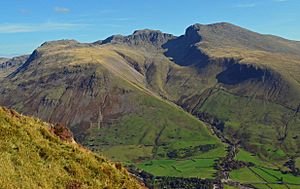
The mountains of the Lake District are called the "Cumbrian Mountains" or "Lakeland Fells". The four highest fells are:
- Scafell Pike, 978 meters (3,209 feet)
- Scafell, 965 meters (3,166 feet)
- Helvellyn, 951 meters (3,118 feet)
- Skiddaw, 931 meters (3,054 feet)
Different Fell Areas
The fells are grouped into different areas:
- Northern Fells: These hills are found between Keswick and Caldbeck. Skiddaw is the highest at 931 meters (3,054 feet).
- North Western Fells: Located between Borrowdale and Bassenthwaite Lake. Grasmoor is the highest here at 852 meters (2,795 feet).
- Western Fells: These are between Buttermere and Wasdale. This area is very rocky and steep. Wastwater is England's deepest lake, found here.
- Central Fells: These fells are lower, reaching 762 meters (2,500 feet) at High Raise. They form a ridge between Derwent Water and Thirlmere.
- Eastern Fells: This area includes the Helvellyn range, with Helvellyn at 951 meters (3,118 feet). The eastern sides have rocky cliffs.
- Far Eastern Fells: These are east of Ullswater. High Street is the highest point at 828 meters (2,717 feet).
- Southern Fells: This area has England's highest mountains, Scafell Pike and Scafell. It also includes the Wastwater Screes and the Coniston Old Man. These are some of the roughest hillsides in the Lake District.
- Southeastern Area: This part is between Coniston Water and Windermere. It has lower hills and forests, like Grizedale Forest.
Valleys and Lakes
The main valleys spread out like spokes on a wheel from the center of the Lake District. These include Dunnerdale, Eskdale, Wasdale, Ennerdale, and the Ullswater valley. These valleys divide the mountains into different sections.
Only one large body of water in the Lake District is actually called a "lake": Bassenthwaite Lake. The others are called "waters" (like Windermere) or "meres" (like Buttermere) or "tarns" (small mountain lakes).
Here are some of the major lakes and reservoirs:
Woodlands and Coast
The Lake District has many wooded areas below the tree line. These include native oak forests and planted conifer trees. These woodlands are home to lots of English wildlife, including the rare native red squirrel. The high rainfall in some areas helps special mosses, ferns, and lichens grow.
The Lake District also meets the Irish Sea on its western and southern sides. Here, you'll find estuaries (where rivers meet the sea) with sand, shingle, and mudflats. There are also sand dunes that are protected nature reserves. To the south, the district also touches the tidal waters of Morecambe Bay.
Geology and Climate
Rock Formations
The Lake District's rocks are very old and complex. A large mass of granite deep underground pushes the area up, creating the mountains. You can see this granite at the surface in places like Ennerdale and Skiddaw.
The rocks generally get younger as you go from northwest to southeast.
- The northwest has older rocks, mostly mudstones and siltstones, which form mountains with smoother slopes like Skiddaw.
- The central part has volcanic rocks, like those found around Scafell Pike. These rocks create the craggy, rocky landscapes you see in the central fells.
- The southeast has younger mudstones and other rocks. These are less resistant to erosion and form the lower hills around Coniston Water and Windermere.
Weather in the Lake District
The Lake District is the wettest part of England because of its location and mountains. The average rainfall is over 2,000 millimeters (79 inches) per year. Some places, like Seathwaite, get over 3,300 millimeters (130 inches) of rain a year! The driest months are usually March to June.
It can be very windy, especially on the fell tops, where there are gales about 100 days a year. Temperatures are mild, ranging from about 3°C (37°F) in January to 15°C (59°F) in July. Snow usually falls between November and April, but the fells can be snow-free at any time. Hill fog is common, and the fells don't get much sunshine, averaging about 2.5 hours per day.
| Climate data for Keswick, Lake District (1991–2020 averages) | |||||||||||||
|---|---|---|---|---|---|---|---|---|---|---|---|---|---|
| Month | Jan | Feb | Mar | Apr | May | Jun | Jul | Aug | Sep | Oct | Nov | Dec | Year |
| Mean daily maximum °C (°F) | 7.4 (45.3) |
7.8 (46.0) |
9.7 (49.5) |
12.4 (54.3) |
15.8 (60.4) |
18.2 (64.8) |
19.8 (67.6) |
19.2 (66.6) |
17.0 (62.6) |
13.5 (56.3) |
10.0 (50.0) |
7.8 (46.0) |
13.2 (55.8) |
| Daily mean °C (°F) | 4.7 (40.5) |
4.8 (40.6) |
6.3 (43.3) |
8.4 (47.1) |
11.3 (52.3) |
14.0 (57.2) |
15.7 (60.3) |
15.3 (59.5) |
13.2 (55.8) |
10.2 (50.4) |
7.1 (44.8) |
4.9 (40.8) |
9.7 (49.4) |
| Mean daily minimum °C (°F) | 2.0 (35.6) |
1.8 (35.2) |
2.8 (37.0) |
4.4 (39.9) |
6.8 (44.2) |
9.7 (49.5) |
11.6 (52.9) |
11.4 (52.5) |
9.4 (48.9) |
6.8 (44.2) |
4.2 (39.6) |
1.9 (35.4) |
6.1 (43.0) |
| Average precipitation mm (inches) | 172.5 (6.79) |
135.4 (5.33) |
114.9 (4.52) |
82.8 (3.26) |
81.6 (3.21) |
89.9 (3.54) |
94.9 (3.74) |
120.2 (4.73) |
124.4 (4.90) |
175.0 (6.89) |
188.6 (7.43) |
195.2 (7.69) |
1,575.4 (62.03) |
| Average precipitation days (≥ 1 mm) | 16.8 | 14.3 | 14.1 | 12.5 | 12.4 | 12.7 | 13.5 | 15.2 | 13.5 | 17.0 | 18.2 | 17.8 | 178 |
| Source: UK Met Office | |||||||||||||
Wildlife and Nature
Animals of the Lake District
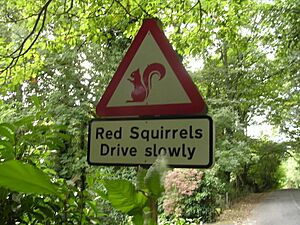
The Lake District has many different kinds of wildlife because of its varied landscape. It's one of the few places in England where you can still find the native red squirrel. There are also special carnivorous plants like sundew and butterwort.
Many bird species live here. The RSPB has a reserve at Haweswater. After being gone for over 150 years, ospreys started nesting again near Bassenthwaite Lake in 2001. They now fly north from Africa each spring to nest here. Red kites have also been reintroduced and are starting to breed successfully. Other birds you might see include buzzards, dippers, and peregrine falcons.
The lakes are home to three rare and endangered fish species. The vendace is England's rarest fish, found only in Derwent Water and Bassenthwaite Lake. They have been moved to higher lakes to protect them. The schelly lives in Brothers Water and Ullswater, and the Arctic charr can be found in many lakes like Windermere and Coniston Water.

To protect these rare fish, new rules were made in 2002. It is now against the law to use any freshwater fish as live or dead bait in 14 of the Lake District's lakes. This helps stop new fish species from being introduced, which can harm the native fish by eating their eggs or competing for food. For example, a fish called the ruffe eats vendace eggs, which are at risk for a long time.
Economy and History
Farming and Forests
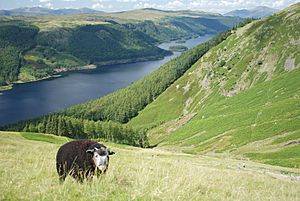
Farming, especially sheep farming, has been important in the Lake District since Roman times. The tough Herdwick sheep are famous here. Sheep farming helps keep the landscape looking the way visitors expect, with features like dry stone walls. Some land is also used for dairy farming.

In 2001, a foot-and-mouth disease outbreak badly affected the area. Thousands of sheep, including the Herdwick, had to be destroyed. It was a big problem because these sheep "knew" their part of the unfenced fells, passing this knowledge down through generations. Now, the sheep are back in abundance.
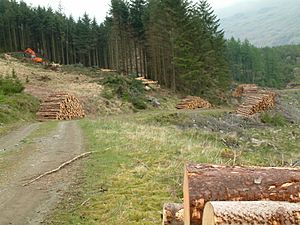
Forestry has also become more important. There are large areas of planted conifer trees, like in Grizedale Forest.
Local Industries
Mining and quarrying have been important for a long time. In ancient times, the Lake District was a major source of stone axes. Later, people mined copper, lead, and slate. Slate mining still happens today at the Honister Mines. The local graphite also led to the development of the pencil industry in places like Keswick.
In the mid-1800s, half of the world's textile industry's bobbins came from this area! But over the last century, tourism has grown to be the main source of income.
How Tourism Grew
Early Visitors
In the 1700s, people started visiting the Lake District for pleasure. Thomas West wrote A Guide to the Lakes in 1778, which helped start modern tourism. He suggested "stations," or viewpoints, where tourists could enjoy the best scenery.
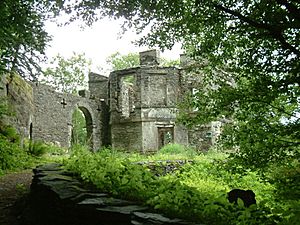
William Wordsworth, a famous poet, also wrote a popular guide to the Lakes. His book helped many people discover the beauty of the region.
Railways and Cars
The arrival of railways in the mid-1800s brought many more visitors. Lines reached Windermere in 1847 and Keswick in 1865. Steamer boats on the major lakes also became popular.

When cars became common, even more people visited. The creation of the Lake District National Park in 1951 helped protect the area while still allowing visitors to enjoy it.
Modern Tourism
Today, tourism is the park's biggest industry, with about 12 million visitors each year. Many come from the UK, China, Japan, and the US. While tourism brings money, it also causes problems like traffic jams and damage to popular walking paths. Millions of pounds are spent to fix these paths.
Cycling is very popular, with long-distance routes like the C2C going through the park. Mountain bikers enjoy trails in Whinlatter and Grizedale Forests.
The Lake District is also known for its cultural tourism. Its connections to famous writers and artists, and its theaters and festivals, attract many visitors. The World of Beatrix Potter and Dove Cottage (Wordsworth's home) are popular attractions.
Food and Drink
The Lake District is known for its excellent lamb and mutton, used in traditional dishes like Tatie Pot. The Traditional Cumberland sausage is also famous. The area now has a growing reputation for fine dining, with several Michelin Star restaurants. Many local breweries and distilleries make ales, lagers, and craft gins.
Literature and Arts
Literary Inspiration
The Lake District has inspired many writers. William Wordsworth is one of the most famous. He lived there for sixty years, and his poems, like "I Wandered Lonely as a Cloud" (inspired by daffodils on Ullswater), are very well known. Wordsworth, Coleridge, and Southey were called the "Lake Poets."
Other writers also lived in or visited the area, including Thomas de Quincey and John Ruskin. Even Jane Austen's character Elizabeth Bennet in Pride and Prejudice wanted to visit the Lake District!
In the 20th century, children's author Beatrix Potter lived at Hill Top Farm. Many of her famous Peter Rabbit books are set in the Lake District. Arthur Ransome also set five of his Swallows and Amazons series books in a fictional Lake District. The novelist Sir Hugh Walpole wrote his Herries Chronicle about a Cumbrian family while living near Derwent Water.
More recently, the Lake District has been the setting for crime novels and other books. Memoirist James Rebanks has written popular books about his life as a sheep farmer in the area.
Visual Arts and Music

Many artists have painted the beautiful landscapes of the Lakes, including Alfred Heaton Cooper. The German artist Kurt Schwitters lived in the Lake District for the last years of his life. Film director Ken Russell also lived here and used the area in his movies.
The Keswick School of Industrial Art was started in 1884 to promote local crafts. Today, Grizedale Arts supports contemporary artists and has helped launch the careers of several famous artists.
The English composer Sir Arthur Somervell was born in Windermere. More recently, American singer-songwriter Taylor Swift released a song called "The Lakes" in 2020, which talks about her experience living in the Lake District and mentions William Wordsworth.
Local Words
Some words and phrases are special to the Lake District and are part of the local Cumbrian dialect:
- Fell: Means mountain, from an old Norse word.
- Howe: A place name meaning hill or mound, also from Old Norse.
- Tarn: A small lake, usually found in a mountain hollow. This word also comes from Old Norse.
- Yan tan tethera: A traditional system for counting sheep.
- Heaf: The "home territory" of a flock of sheep, which they learn and pass down.
Images for kids
See also
 In Spanish: Parque nacional del Distrito de los Lagos para niños
In Spanish: Parque nacional del Distrito de los Lagos para niños


